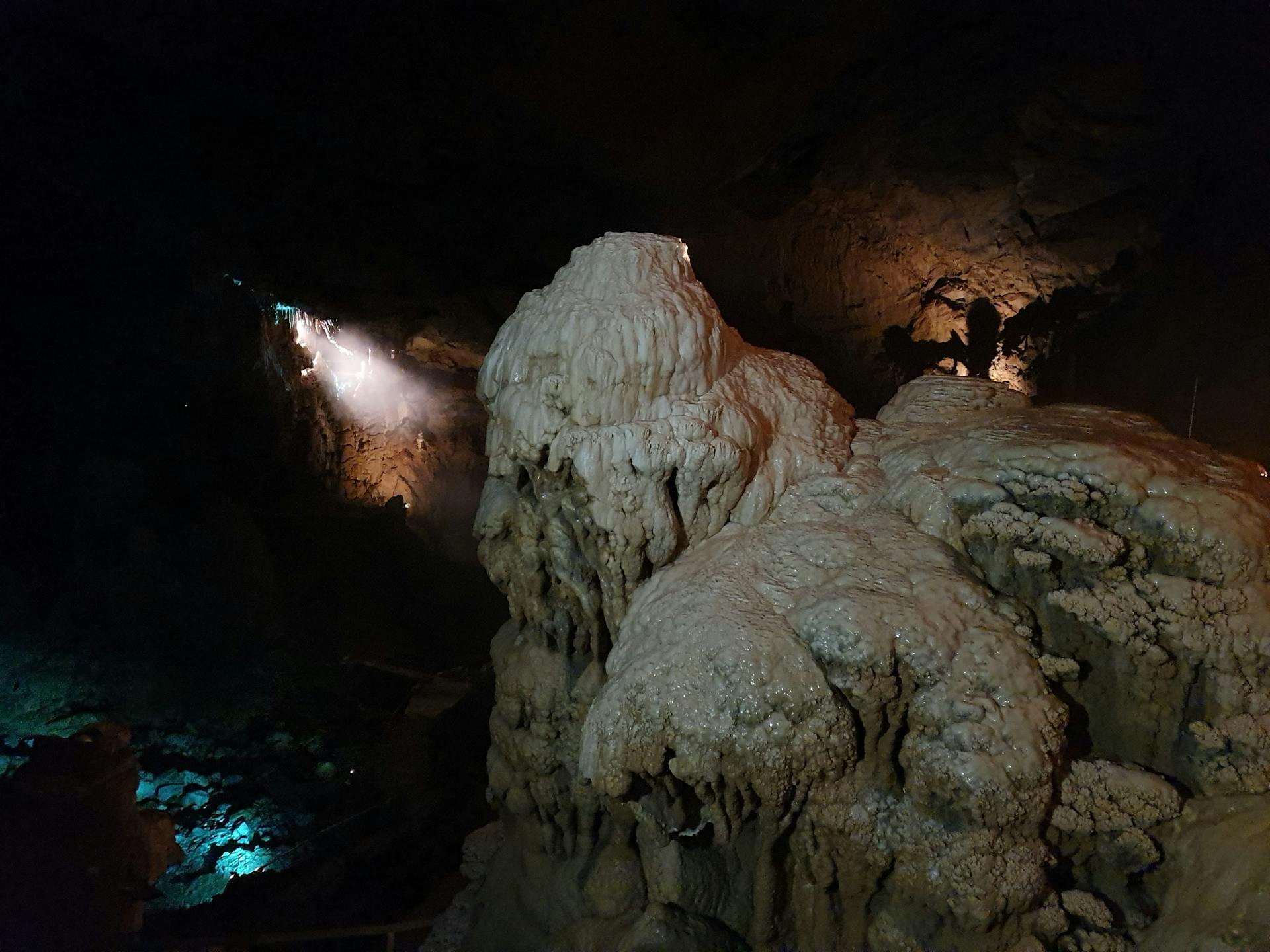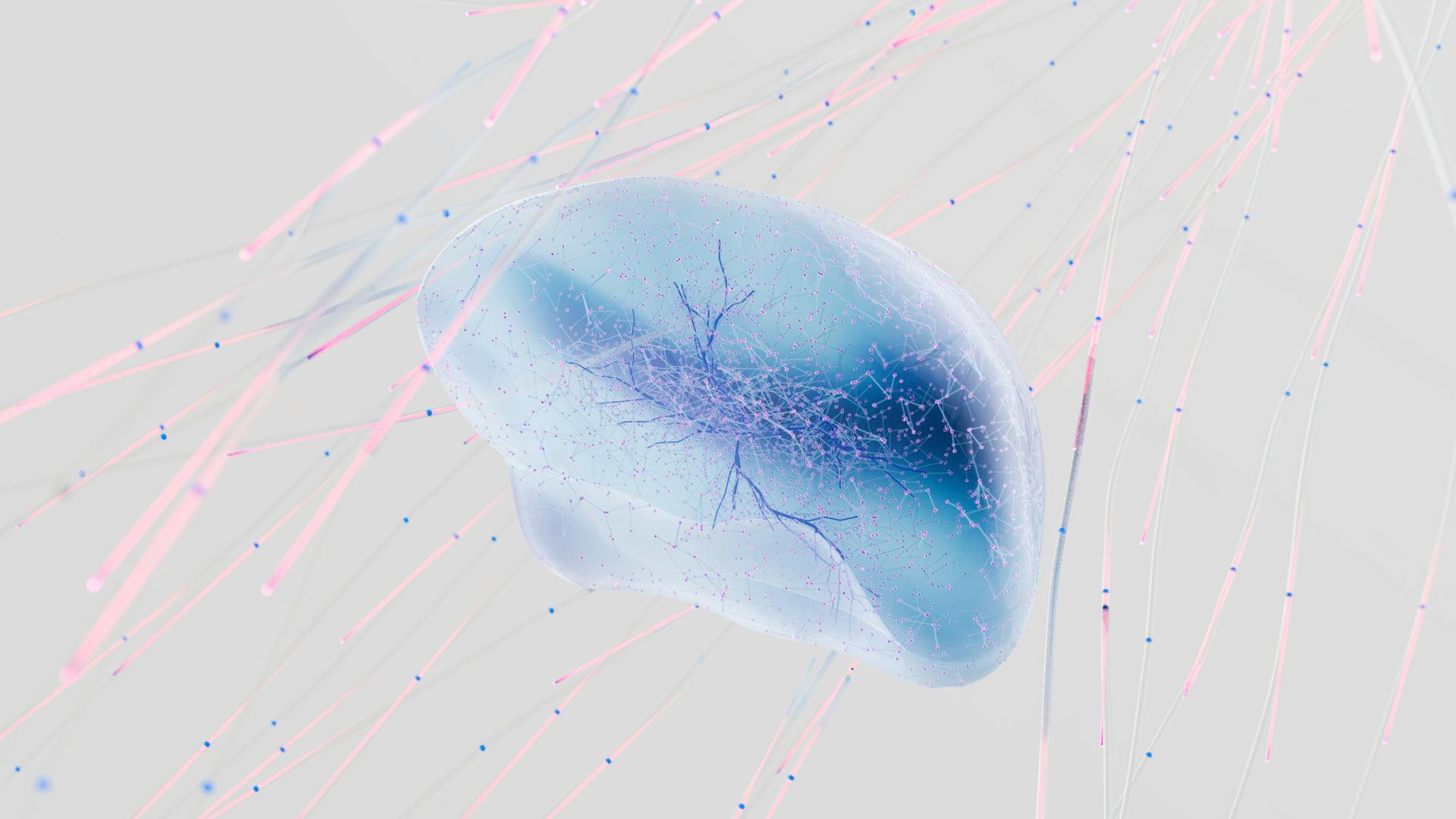
Hidden layers in neural network architecture are a crucial component of deep learning models. They allow the network to learn complex representations of data by stacking multiple layers of artificial neurons.
Each hidden layer processes the input data in a unique way, enabling the network to capture different features and patterns. This is achieved through the use of activation functions, such as the sigmoid or ReLU function.
A hidden layer typically consists of multiple neurons, each with its own set of weights and biases. This allows the network to learn a wide range of representations, from simple linear relationships to complex non-linear interactions.
The number of hidden layers and the number of neurons in each layer can be adjusted to suit the specific needs of the problem being solved.
Take a look at this: Transfer Learning Enables Predictions in Network Biology
What is a Network?
A network is essentially a series of interconnected layers that work together to process information.
In the context of artificial neural networks, a network typically consists of three main layers: the input layer, the hidden layer, and the output layer.
The input layer is where the network receives the data it needs to process, while the output layer is where the network produces its results.
The hidden layer, which we'll explore in more detail later, is where the magic happens and the network learns to recognize patterns in the data.
A hidden layer is a fundamental component of artificial neural networks, positioned between the input layer and the output layer.
These layers play a crucial role in transforming the input data into a format that the network can use to make predictions or classifications.
The more layers a neural network contains, the "deeper" the learning algorithm, and the more complex the interactions between the input and output can become.
In fact, a simple neural network might contain just one hidden layer, but including additional layers allows the network to interact with the input in more complex ways.
Each hidden layer can look at a different aspect of the input or recognize more specific features layer by layer, compounding this information from one layer to the next.
Take a look at this: Hidden Technical Debt in Machine Learning Systems
Network Architecture
Hidden layers are the backbone of neural networks, and understanding their role is crucial for building effective models. They're everything between the input and output layers, making the artificial intelligence "deeper".
Each hidden layer contains neurons known as nodes, which interact with the data in one simple way, such as completing a calculation or detecting a specific feature.
The number of layers in each neural network depends on the goals you wish to accomplish with the algorithm, but deep learning isn’t possible with a single hidden layer between the input and the output layers.
Data flows through the input and then enters the first layer of nodes, which changes or reacts to the data and passes the new information set to the next hidden layer.
Every node in each layer connects to each node in the next layer, passing down what it discovered about the data.
Some of the most common types of neural networks are recurrent, generative adversarial, and convolutional.
Training
Training hidden layers involves adjusting the weights of the connections between neurons through a process called backpropagation.
The learning rate, which determines the size of the weight updates, is a critical hyperparameter that influences the training process. A well-tuned learning rate can significantly impact the model's performance and efficiency.
During training, the network makes predictions based on the input data, calculates the error between the predicted and actual outputs, and then propagates this error backward through the network. This process updates the weights in the hidden layers to minimize the error.
Training a neural network with multiple hidden layers can be more complex, but it allows the model to learn intricate patterns from large datasets. In fact, starting with one or two hidden layers is often sufficient for many problems.
Network Benefits and Features
Hidden layers are instrumental in feature extraction, which is the process of identifying and isolating relevant features from raw data. This process enables neural networks to outperform traditional statistical methods in many applications.
In tasks such as image classification, initial hidden layers may learn to detect edges and textures, while deeper layers may learn to recognize shapes and objects. This hierarchical feature extraction is a key advantage of using hidden layers.
Hidden layers are utilized across various applications in data science, including image and speech recognition, natural language processing, and time series forecasting. The ability of hidden layers to learn intricate patterns from large datasets drives advancements in technology and analytics.
A hierarchical architecture offers several benefits, including faster convergence and better generalization. Faster convergence means that DNNs can converge more quickly to a good solution because they efficiently model the hierarchical structure of data.
Here are some key benefits of a hierarchical architecture:
- Faster Convergence: DNNs can converge more quickly to a good solution.
- Better Generalization: DNNs can generalize better to new datasets.
By effectively utilizing hidden layers, data scientists can build models that are more robust and capable of handling high-dimensional data.
Network Types and Techniques
Convolutional neural networks have three main types of hidden layers: convolutional layers, pooling layers, and fully connected layers. These layers work together to extract features, simplify the data, and classify the output.
Intriguing read: Hidden Layers in Neural Networks Code Examples Tensorflow
A convolutional layer uses feature extraction to perform the main "work" of the CNN, creating a map of the features it finds. Convolutional layers can have many layers, each adding a more nuanced understanding of the input.
Here are the three main types of hidden layers in a convolutional neural network:
- Convolutional layers: extract features from the input
- Pooling layers: simplify the data, losing some information in the process
- Fully connected layers: map the information gained from the previous layers, classifying it for output
The fully connected layer is named as such because every node in this layer connects to every node in the previous layer.
Convolutional
Convolutional layers are the heart of Convolutional Neural Networks (CNNs), and they're primarily used for image processing tasks. They apply convolution operations to the input, capturing spatial hierarchies in the data.
Convolutional layers use filters to scan across the input and generate feature maps, which helps in detecting edges, textures, and other visual features. This process is essential for tasks like object detection and image classification.
A convolutional layer extracts spatial features from images, which is a critical step in image processing. It's like a magnifying glass that helps the network zoom in on specific details.
Convolutional layers can have many layers, with each layer adding a more nuanced understanding of the input. This is because each layer can use a different filter to scan the input, generating a more detailed feature map.
Here are the main roles of convolutional layers:
- Extracts spatial features from images.
- Applies convolution using filters.
- Detects edges and textures in images.
Recurrent Networks
Recurrent neural networks are designed to work specifically with time series data or sequential data. They can assist in making predictions about future events based on past data or in replicating human speech by understanding how the word order in a sentence affects the meaning of the sentence.
The hidden layers in a recurrent neural network contain nodes that can remember the results of previous calculations, allowing the network to predict the current input based on past results. These stored memories are in a hidden state within the hidden layers.
Recurrent layers, such as Long Short-Term Memory (LSTM) and Gated Recurrent Unit (GRU), are used in Recurrent Neural Networks (RNNs) for sequence data like time series or natural language. They have connections that loop back, allowing information to persist across time steps.
Additional reading: Energy Based Model
These layers are suitable for tasks where context and temporal dependencies are important, such as language modeling and time series prediction. Recurrent layers can process sequential data with temporal dependencies and maintain state across time steps.
Here's a brief overview of some common types of recurrent layers:
- Role: Processes sequential data with temporal dependencies.
- Function: Maintains state across time steps.
- Example: Language modeling, time series prediction.
Regularization Techniques
Regularization Techniques are a must-have in models with multiple hidden layers to prevent overfitting. Regularization Techniques are a must-have in models with multiple hidden layers to prevent overfitting.
L1 and L2 regularization are two popular methods that add a penalty to the loss function based on the magnitude of the weights. This discourages overly complex models from being trained.
Dropout is another technique that randomly deactivates a subset of neurons during training. This forces the network to learn redundant representations and improves generalization.
These regularization strategies are essential for maintaining the balance between model complexity and performance.
See what others are reading: Applied Machine Learning Explainability Techniques
Frequently Asked Questions
How do I show all hidden layers in Photoshop?
To show all hidden layers in Photoshop, press-and-hold the Option (PC: Alt) key and click on the Eye icon of any visible layer. This will toggle all layers back to visible.
Sources
- https://statisticseasily.com/glossario/what-is-hidden-layer/
- https://www.geeksforgeeks.org/layers-in-artificial-neural-networks-ann/
- https://www.coursera.org/articles/hidden-layer-neural-network
- https://stackoverflow.com/questions/57369148/what-do-hidden-layers-mean-in-a-neural-network
- https://medium.com/@sanjay_dutta/understanding-the-number-of-hidden-layers-in-neural-networks-a-comprehensive-guide-0c3bc8a5dc5d
Featured Images: pexels.com

